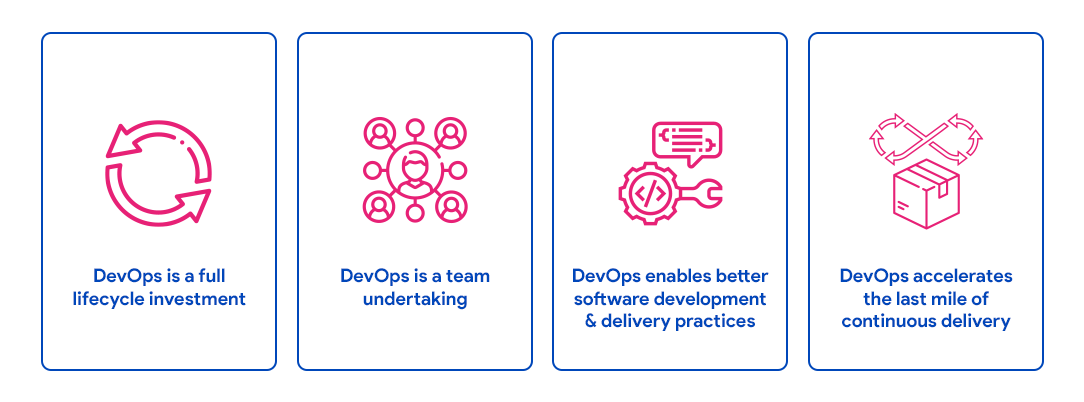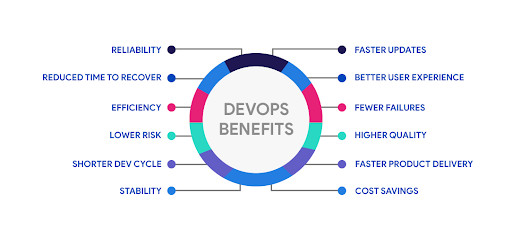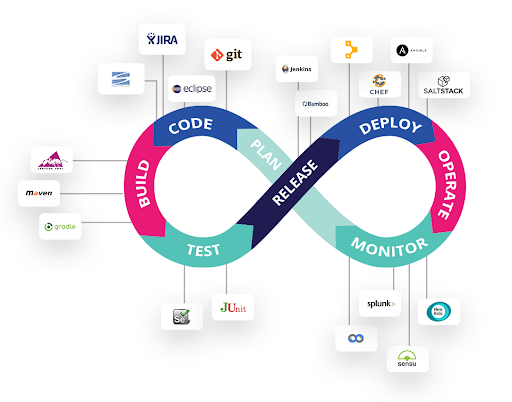DevOps, what is it, and why is it used?
DevOps, what is it, and why is it used?

Starting with the “what” listed in the title of this piece, DevOps is simply shortened from the two words Development and Operations. Its primary aim is to reduce the systems development life cycle and provide continuous delivery with high software quality. DevOps is the next generation of agile software development. The whole concept started with the demand to contend with increased software velocity. A way to automatically integrate the process between code development and IT teams, so they are able to build, test and deliver the software faster and more dependably. This bridges the gap between the two teams that have usually worked apart.
Now on to the why. Here’s a common Pre-DevOps rundown. The Dev (Development) team has an objective to produce and ship as many new features as possible and kicks a new release ‘over the wall’ to QA. Then the tester’s goal is to locate as many bugs as possible. After receiving the results from the testers, that have run the software in the controlled environment, the developers become very intimidated and blame the testers for the wrong environment. The testers reply by saying the problem isn’t the environment, but the developers software is generating the problem and the finger pointing begins. Ultimately the problems are resolved and QA sends the debugged new released features ‘over the wall’ to Ops (Operations). Their goal is to keep changes to a minimum, the code is nervously released and the system fails. The blaming game starts again. Ops tells the Devs that they have given them malfunctioning components and the Devs reply by saying that everything worked well in the controlled testing environment. The responsibility to fix these issues doesn’t fall to QA’s and Dev’s so they don’t go near the problem and Ops is left to fix the production issue. Eventually the system is debugged and stabilizes.
Strategy and consulting companies like Commencis are among the key players that implement DevOps and work with companies like Amazon Web Services to ensure their clients are able to deliver high quality products, quickly and efficiently. For more details on Commencis, visit this link.
What is the main purpose of DevOps
To enhance and reform cooperation between all team members from planning through delivery whist automating the whole process in order to:
- Boost Deployment frequency
- Achieve more expeditious time to market
- Decrease failure rate of new releases
- Shorten lead time between fixes
- Improve average time to recovery
The 2015 State of DevOps Report quoted the following “high-performing IT organizations deploy 30 times more frequently with 200 times shorter lead times; they have 60 times fewer failures and recover 168 times faster.”
A Familiar DevOps Synopsis
Before starting a new project the software team meet up. The team encompasses testers, operations, developers, and support professionals. A plan is worked on to establish a functioning piece of software that is ready activation. Every day as each new piece of software is prepared the developers complete it. The software is tested automatically to make sure it is ready to be activated. Once the code passes all the automatic testing, a smaller group of users get their hands on it. Monitoring of the new software continues for a short while just in case there are any unanticipated problems that might occur and that the software is stable. Virtually no human intervention occurs after planning and development are done.
1. A faster discharge and a smarter work flow
Speed is everything. DevOps teams discharge product much faster and more often, with higher standards and cohesion. Without having to have many review cycles and tests that slow the release to production, and without having to wait for incident response times that kill the speed, team morale is much higher. Operating costs are increased due to diverse tools and processes. However, tools that drive automation attract less hiccups and productivity is increased.
2. Administer unplanned work more efficiently
The reality is that every team faces unplanned work – and this always effects productivity in the team. With clear priorities that are established with a process, DevOps teams can administer unplanned work while continuing to focus on the planned jobs. This also raises visibility and teams can me proactive, anticipate and share unplanned work.
3. Speed up time to conclusion
The team that blossoms is always the team that has the fastest feedback loop. The DevOps team communicate seamlessly and with full transparency, which in turn keeps downtime to a minimum and issues are resolved faster. Customer satisfaction diminishes when important issues are not solved quickly. Without transparent communication, important issues can be over looked, resulting to tension increase and team frustration. All these key features unblock the pipeline and everything runs faster.

Behind The Scenes
Just like all technology many tools emerge to make life easier. Even though DevOps was never supposed to be about these so called tools in the original concept, they have created a place in the market. According to a few research companies, a linked toolchain of technologies is now very important for all DevOps teams, if they truly want to bring the changes that are supposed to happen. Recently, there have been an outbreak of DevOps tools and for different practices. Here are some examples.

Key Takeaways
Companies like Facebook, Amazon, Netflix and Etsy are just a few of the success stories that have adopted the use of DevOps. Recent surveys show that 74% of new start-ups and more established companies have already implemented this strategy in one form or another.
“DevOps is not a goal, but a never-ending process of continual improvement.”
Jez Humble, Founder and CTO, DevOps Research and Assessment
The data is clear, after ten years or so in to the DevOps undertaking, it seems it is here for good. Although many people thought the whole process would have been impossible, DevOps has been successful by unifying business users, the whole software team and system administrators into a single minded workflow focusing on the needs of the customer. Why has it been successful? Because everyone benefits. Arguments and blood pressures are reduced, and everyone starts to support each other. Plus everyone from the business manager to the top executives are happy and everyone delivers the best outcome and experience to the customer.
Reading Time: 7 minutes
Don’t miss out the latestCommencis Thoughts and News.

Umut Yalçınkaya / Cloud Engineer
27/10/2020
Reading Time: 7 minutes

Starting with the “what” listed in the title of this piece, DevOps is simply shortened from the two words Development and Operations. Its primary aim is to reduce the systems development life cycle and provide continuous delivery with high software quality. DevOps is the next generation of agile software development. The whole concept started with the demand to contend with increased software velocity. A way to automatically integrate the process between code development and IT teams, so they are able to build, test and deliver the software faster and more dependably. This bridges the gap between the two teams that have usually worked apart.
Now on to the why. Here’s a common Pre-DevOps rundown. The Dev (Development) team has an objective to produce and ship as many new features as possible and kicks a new release ‘over the wall’ to QA. Then the tester’s goal is to locate as many bugs as possible. After receiving the results from the testers, that have run the software in the controlled environment, the developers become very intimidated and blame the testers for the wrong environment. The testers reply by saying the problem isn’t the environment, but the developers software is generating the problem and the finger pointing begins. Ultimately the problems are resolved and QA sends the debugged new released features ‘over the wall’ to Ops (Operations). Their goal is to keep changes to a minimum, the code is nervously released and the system fails. The blaming game starts again. Ops tells the Devs that they have given them malfunctioning components and the Devs reply by saying that everything worked well in the controlled testing environment. The responsibility to fix these issues doesn’t fall to QA’s and Dev’s so they don’t go near the problem and Ops is left to fix the production issue. Eventually the system is debugged and stabilizes.
Strategy and consulting companies like Commencis are among the key players that implement DevOps and work with companies like Amazon Web Services to ensure their clients are able to deliver high quality products, quickly and efficiently. For more details on Commencis, visit this link.
Don’t miss out the latestCommencis Thoughts and News.
What is the main purpose of DevOps
To enhance and reform cooperation between all team members from planning through delivery whist automating the whole process in order to:
- Boost Deployment frequency
- Achieve more expeditious time to market
- Decrease failure rate of new releases
- Shorten lead time between fixes
- Improve average time to recovery
The 2015 State of DevOps Report quoted the following “high-performing IT organizations deploy 30 times more frequently with 200 times shorter lead times; they have 60 times fewer failures and recover 168 times faster.”
A Familiar DevOps Synopsis
Before starting a new project the software team meet up. The team encompasses testers, operations, developers, and support professionals. A plan is worked on to establish a functioning piece of software that is ready activation. Every day as each new piece of software is prepared the developers complete it. The software is tested automatically to make sure it is ready to be activated. Once the code passes all the automatic testing, a smaller group of users get their hands on it. Monitoring of the new software continues for a short while just in case there are any unanticipated problems that might occur and that the software is stable. Virtually no human intervention occurs after planning and development are done.
The Three Main Benefits of DevOps?
1. A faster discharge and a smarter work flow
Speed is everything. DevOps teams discharge product much faster and more often, with higher standards and cohesion. Without having to have many review cycles and tests that slow the release to production, and without having to wait for incident response times that kill the speed, team morale is much higher. Operating costs are increased due to diverse tools and processes. However, tools that drive automation attract less hiccups and productivity is increased.
2. Administer unplanned work more efficiently
The reality is that every team faces unplanned work – and this always effects productivity in the team. With clear priorities that are established with a process, DevOps teams can administer unplanned work while continuing to focus on the planned jobs. This also raises visibility and teams can me proactive, anticipate and share unplanned work.
3. Speed up time to conclusion
The team that blossoms is always the team that has the fastest feedback loop. The DevOps team communicate seamlessly and with full transparency, which in turn keeps downtime to a minimum and issues are resolved faster. Customer satisfaction diminishes when important issues are not solved quickly. Without transparent communication, important issues can be over looked, resulting to tension increase and team frustration. All these key features unblock the pipeline and everything runs faster.

Behind The Scenes
Just like all technology many tools emerge to make life easier. Even though DevOps was never supposed to be about these so called tools in the original concept, they have created a place in the market. According to a few research companies, a linked toolchain of technologies is now very important for all DevOps teams, if they truly want to bring the changes that are supposed to happen. Recently, there have been an outbreak of DevOps tools and for different practices. Here are some examples..

Key Takeaways
Companies like Facebook, Amazon, Netflix and Etsy are just a few of the success stories that have adopted the use of DevOps. Recent surveys show that 74% of new start-ups and more established companies have already implemented this strategy in one form or another.
“DevOps is not a goal, but a never-ending process of continual improvement.”
Jez Humble, Founder and CTO, DevOps Research and Assessment
The data is clear, after ten years or so in to the DevOps undertaking, it seems it is here for good.
Although many people thought the whole process would have been impossible, DevOps has been successful by unifying business users, the whole software team and system administrators into a single minded workflow focusing on the needs of the customer. Why has it been successful? Because everyone benefits. Arguments and blood pressures are reduced, and everyone starts to support each other. Plus everyone from the business manager to the top executives are happy and everyone delivers the best outcome and experience to the customer.




